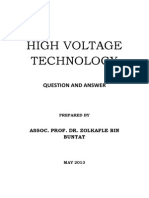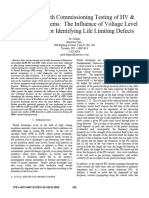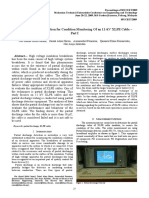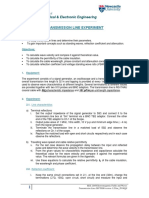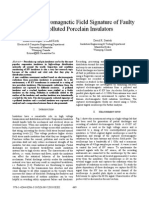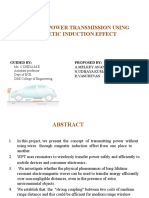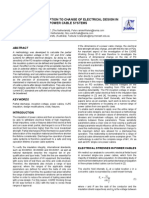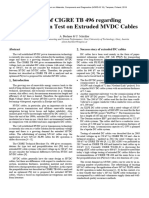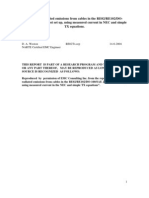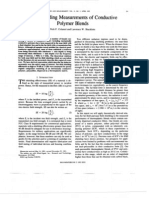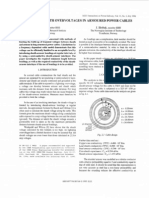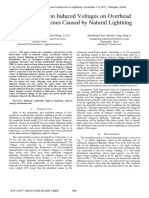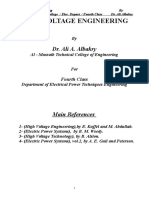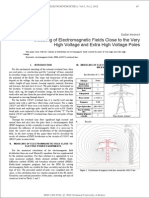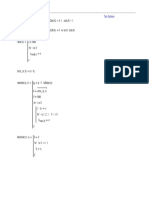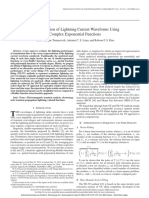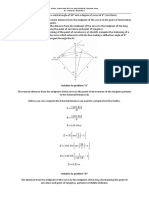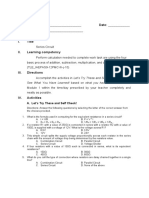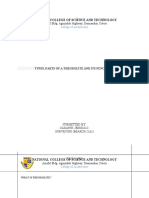Measurements of Leakage Current and Field Enhancement in Extruded Model Cables at HVDC
Measurements of Leakage Current and Field Enhancement in Extruded Model Cables at HVDC
Uploaded by
임광식Copyright:
Available Formats
Measurements of Leakage Current and Field Enhancement in Extruded Model Cables at HVDC
Measurements of Leakage Current and Field Enhancement in Extruded Model Cables at HVDC
Uploaded by
임광식Original Title
Copyright
Available Formats
Share this document
Did you find this document useful?
Is this content inappropriate?
Copyright:
Available Formats
Measurements of Leakage Current and Field Enhancement in Extruded Model Cables at HVDC
Measurements of Leakage Current and Field Enhancement in Extruded Model Cables at HVDC
Uploaded by
임광식Copyright:
Available Formats
2013 IEEE International Conference on Solid Dielectrics, Bologna, Italy, June 30 – July 4, 2013
Measurements of Leakage Current and Field
Enhancement in Extruded Model Cables at HVDC
Carl-Olof Olsson and Birgitta Källstrand
Corporate Research, Dept. Power Technologies
ABB AB
Västerås, Sweden
carl-olof.olsson@se.abb.com
birgitta.kallstrand@se.abb.com
Abstract—In the characterization of insulation materials for test rooms. The main focus has been on characterizing the
extruded HVDC cables, measurements of leakage current and conductivity of the cable insulation using leakage current and
space charge distribution are often used. The apparent PEA measurements. The measurement methods and the data
conductivity that can be obtained from leakage current should be evaluation will be described, and examples of two cables will
in agreement with the conductivities that can be evaluated from be given. The two cables have conductivities that differs
the time evolution of space charge from voltage application until approximately a factor 100, and the consequences on the time
steady-state. In this paper, examples of leakage current data and evolution and the required measurement time are discussed.
space charge data for two cables having different levels of Further information on space charge measurements are found
conductivity are presented. The similarities in the results are in e.g. [1] to [4], and the relevance of conductivity and of
shown, and differences as well as future challenges are discussed.
conductivity distribution for HVDC cables have been discussed
Keywords—HVDC; cable; leakage current; conductivity; in [5] and [6].
electric field; space charge; PEA
II. MEASUREMENT TECHNIQUES
I. INTRODUCTION
A. Space Charge Measurements
Extruded insulation systems for high voltage cables have
been used since more than 50 years for AC and about 20 years Space charge measurements were made using the pulsed
for DC. While the permittivity is the property that dictates the electro-acoustic method. The PEA system used has been built
distribution of the electric field at AC, the distribution of in-house [7]. A voltage pulse of +3.5 kV is applied and the
conductivity gives the electric field at DC when a steady-state acoustic response that depends on the charge density is
is reached. In almost every type of insulation system there will measured. The measurement cell used for the measurements
be gradients in conductivity within the insulation due to e.g. presented here is specially made for cables with an outer
cylindrical geometry as for cables and variations in the diameter of 20-30 mm.
composition and/or temperature across the insulation layer. The signal is corrected for the combined effect of the
Due to such conductivity gradients there will be a difference in divergence of both pulsed field and acoustic waves that is due
the field distribution from the first voltage application to the to the cylindrical geometry, in the same way as described in
steady-state. This can be seen in space charge measurements in [4]. The measured signals were calibrated to the relative value
which the radial distribution of charge within the insulation called Field Enhancement Factor, FEF, according to
together with the interface charge at the electrodes is detected.
Often the signals from the interface charge at the inner and
outer electrodes dominate, and based on the charge magnitude x x0
the electric field at the electrodes can be obtained. In theory, FEF
U
the space charge distribution can be translated into an electric x ref x0ref
U ref
field distribution, but if e.g. PEA (pulsed electro-acoustic
method) is used, the interference of the acoustic signal from
where x is the measured signal, x0 the zero level (the
interface charge with the signal from space charge close to the
electrodes will cause uncertainty in the evaluation of the field measurement raw signal is most often slightly displaced from
distribution. zero) and U the voltage at which the measurement was done.
The first curve at the measurement level (i.e. as soon as the
In the development of HVDC cable systems for increased voltage applied to the cable system has reached the intended
voltage, model cables having 4 mm and 5.5 mm insulation voltage level) is used as reference curve. The FEF can be
thickness have been used. It has then been possible to carry out calculated both for the outer electrode peak and the inner
experiments with an average electric field up to 70 kV/mm and electrode peak. The outer electrode peak corresponds to
temperature up to 90°C without using expensive high voltage interface charge at the outer (negative) semiconductor, and the
978-1-4673-4461-6/13/$31.00 ©2013 IEEE
141 06,2024 at 02:16:42 UTC from IEEE Xplore. Restrictions apply.
Authorized licensed use limited to: Wonkwang Univ. Downloaded on February
2013 IEEE International Conference on Solid Dielectrics, Bologna, Italy, June 30 – July 4, 2013
inner electrode peak to interface charge at the (positive) inner III. RESULTS AND DISCUSSION
semiconductor.
A. Leakage current measurements and simulations
A time constant was estimated from graphs of FEF as a
function of time from voltage application, using the following The measured leakage current as function of time for the
expression: two cables in Fig. 1 is presented as apparent conductivity
according to (4). The measurements were made at room
temperature. The cable with higher conductivity shows a
FEF FEF0 ( FEFmax FEF0 ) (1 e 1 ) conductivity of 22 fS/m (2.2×10-14 S/m) after 24 hours at
150 kV (15 fS/m at the end of the measurement, i.e after 46
where 1-e-1 is approximately equal to 0.63. FEFmax is the hours). After the initial polarization, the conductivity varies
maximum FEF during the measurement and FEF0 is the FEF between 15 fS/m and 44 fS/m. For this cable the variations
at time equal to zero. Since the first measurement at the with time can partly be related to variations in the ambient
measurement level is used for calibration, FEF0 will always be temperature of the test room. For the cable with lower
1. The time constant, , is the time when the FEF has reached conductivity, the end value after six days at 180 kV is
FEF . approximately 0.2 fS/m. The minimum and maximum values
after the initial polarization are approximately 0.09 fS/m and
Using this time constant, the conductivity of the insulation 0.24 fS/m, respectively.
material can be estimated [6]:
The measured leakage currents do not show any particular
trend with time. Theoretically, there should be a slight change
0 r
in current until a steady-state space charge distribution is
established across the insulation layer, but for these two cables
the expected decrease due to the space charge build-up is only
about 10% of the steady-state current, so the variations that are
where 0 is the permittivity of vacuum, 8.85·10-12 As/Vm, seen are most likely related to other factors. The time constants
and r is the relative permittivity of the insulation that for to reach steady-state are very different for the two cables. The
polyethylene is 2.3. end values of conductivity correspond to time constants of
The measurements were typically performed with the approximately 15 minutes and 31 hours, for the high
voltage on during 24 hours, followed by voltage off conductivity cable and low conductivity cable, respectively. In
measurements. However, the measurement time was adapted order to capture the evolution of electric field and space charge
based on the expected time constant for the space charge of the cables, the measurement time has to be about 5 to 10
development. Thus, for a cable with an expected low times longer than the time constant.
conductivity, which implies a long time constant, the
measurement time was extended.
B. Leakage Current Measurements
Leakage current was also measured by using measurement
equipment built in-house. The cable ends are connected to high
voltage outside a large oven, and the main part of the cable is
located on a drum placed inside the oven. The leakage current
electrodes are connected to the cable screen that is cut
approximately at the wall of the oven. The measurement
section of the cable is separated from the terminations in order
to avoid influence of the leakage current from the high voltage
connection along the terminations.
Fig. 1. Measured leakage current at room temperature, shown as apparent
The conductivity ( ) of the insulation material has been conductivity, for the two cables presented in this paper. Cable with higher
calculated from the leakage current, using the following conductivity: 5.5 mm insulation thickness, 150 kV. Cable with lower
conductivity: 4 mm insulation thickness, 180 kV.
equation:
A simulation model [8] has been used to generate a full set
ro of field properties of the experiment by adapting the assumed
I ln conductivity distribution to make the simulation fit to the
ri
measured field enhancement at the outer electrode. A linear
2 UL variation of conductivity with the radius was assumed:
where ro and ri are the outer and the inner radius of the
insulation layer, respectively. U is the applied voltage and L is
the cable length. About 60 meter of cable was used for the
r ri
i o i
leakage current measurements. ro ri
978-1-4673-4461-6/13/$31.00 ©2013 IEEE
142 06,2024 at 02:16:42 UTC from IEEE Xplore. Restrictions apply.
Authorized licensed use limited to: Wonkwang Univ. Downloaded on February
2013 IEEE International Conference on Solid Dielectrics, Bologna, Italy, June 30 – July 4, 2013
where i is set to 57 fS/m and o to 15 fS/m in order to limited bandwidth of the PEA measurement causes the
obtain a good fit to the PEA data for the cable with higher interface signal to decrease when the space charge of opposite
conductivity. The steady-state current of 54 nA/m from the polarity is increasing close to the interface. This effect causes
simulation inserted in (4) gives an apparent conductivity of an uncertainty when the conductivity is estimated based on the
35 fS/m. For several reasons, it might not be realistic to obtain PEA data. In order to illustrate the sensitivity to the
a significantly better match to the measured leakage current. conductivity value for the time constant in the exponential
The leakage current reflects the average conductivity for a long function, two additional curves are included in Fig. 2 giving the
length of the cable whereas the PEA measurement gives FEF as function of time for the assumptions of 15 fS/m and
information about the distribution of conductivity at the 25 fS/m conductivity. These two curves clearly fall at a
position where the measurement cell is mounted. Due to the distance from the measured data indicating that the correct
processing history of the cable there might be variations in the conductivity estimate would be within this interval.
chemical composition in the axial direction that would cause
In the FEM simulations, also included in Fig. 2, the
uncertainties when comparing different positions or comparing
conductivity varies according to (5), and even though the local
one position with the average of the cable. The assumption of a
electric field depends on the entire distribution of conductivity
linear conductivity distribution according to (5) is not the only
and not just the local value, the FEF at the outer electrode is
distribution that could fit the PEA data and other assumptions
primarily dictated by the conductivity close to the electrode –
could give a slightly different apparent conductivity. At
in this case 15 fS/m and higher.
sufficiently high conductivity and electric field, it might be
possible to correlate the temperature rise of the cable surface From the FEM simulations, the distributions of the electric
with the leakage current heating and thus the apparent field, see Fig. 3, and the space charge density, see Fig. 4, can
conductivity, but for the investigated cable with higher be studied. These results thus rely on the assumption of a linear
conductivity the estimated temperature rise is only about distribution of conductivity, i.e. there is no field dependence of
0.01 K. As seen in Fig. 1, the leakage current is varying in time the conductivity in the model. At start, the electric field
during the measurements, and the apparent conductivity distribution is dictated by the permittivity which is assumed
resulting from (5) is between the maximum and minimum constant across the insulation. At the inner electrode the
values obtained from the measurement during the first two electric field is 20.4 kV/mm and at the outer 37.6 kV/mm.
hours. After 5 minutes, the electric field is almost uniform throughout
the insulation and after 15 minutes, i.e. after approximately one
B. Field enhancement measurements and simulations time constant, the highest electric field is found at the outer
The field enhancement is in general defined as the actual electrode. At the inner electrode the electric field is relatively
electric field distribution divided by the capacitive field close to the steady-state value of 23 kV/mm whereas the field
distribution. At the outer interface of a cable the field at the outer electrode is rather far from the steady-state value of
enhancement is easily evaluated from PEA measurements as 44 kV/mm. The evolution of the electric field is faster close to
described above. In Fig. 2 the field enhancement at the outer the inner electrode due to the higher conductivity assumed for
interface is shown from the PEA measurements on the cable this region as compared to the region close to the outer
having higher conductivity. Data were recorded during electrode. The time constants corresponding to the assumed
46 hours, but a steady-state is reached after approximately one conductivities of 57 fS/m and 15 fS/m at the inner and outer
hour and only 3 hours of the data are shown in the figure. electrodes are 6 minutes and 23 minutes, respectively. At
Together with the measurement data the field enhancement steady-state, the FEF at the outer electrode is equal to 2.15 as
evaluated from an FEM simulation and from two exponential shown in Fig. 2, and for the inner electrode the FEF is
functions are shown: approximately 0.6 which is slightly lower than the measured
value of approximately 0.7. The uncertainty of the PEA data is
larger for the inner electrode than for the outer electrode due to
FEF 1 FEFmax 1 1 e t/ the longer acoustic path, but the difference between the actual
conductivity distribution and the assumed linear distribution is
probably the main reason for the deviation.
FEFmax could be taken as the maximum measured field
enhancement at the outer electrode, t is time and is the time The space charge density distribution is shown in Fig. 4. At
constant as defined in (3). start it is assumed to be zero meaning that any history of
voltage application has been removed. After 5 minutes the
The PEA data follows well the exponential curve for the space charge density has increased and is rather uniform across
time constant corresponding to 20 fS/m. In the experimental the insulation. After 15 minutes the space charge density has
data, there is a local maximum after approximately 30 minutes become slightly non-uniform, and close to the inner electrode
that is followed by a decrease from the maximum FEF of 2.0 the value is close to the steady-state whereas at the outer
to 1.85 after long time. The exponential curve is drawn electrode the space charge density is still much lower than the
assuming a final FEF value of 2.15. The reason is that this steady-state value. By comparing the development of electric
gives the best fit to the experimental data up to the maximum field and space charge density in Fig. 3 and Fig. 4 it can be
FEF, and the decrease in the experimental data after the first seen that the FEF at the outer electrode increases more rapidly
30 minutes is most likely due to interference between the signal than the space charge density at the outer electrode. This
from the outer electrode that is negative and the signal from the explains why the measured FEF decreases slightly after the
space charge close to the outer electrode that is positive. The maximum value at 30 minutes when the PEA signal exhibits
978-1-4673-4461-6/13/$31.00 ©2013 IEEE
143 06,2024 at 02:16:42 UTC from IEEE Xplore. Restrictions apply.
Authorized licensed use limited to: Wonkwang Univ. Downloaded on February
2013 IEEE International Conference on Solid Dielectrics, Bologna, Italy, June 30 – July 4, 2013
included in Fig. 5. The curve starting at 1.0 for time equal to
zero does not follow the experimental data very well during the
first two days whereas the curve that has been shifted
approximately 11 hours follows the data rather well except for
the first half day. This cable has a history of voltage
application, and due to the low conductivity there was a non-
zero space charge distribution in the insulation when the
experiment was started. This creates an uncertainty in the
calibration of the field enhancement factor; however it is seen
that the conductivity can still be estimated from the PEA data.
It could be noted that the measured data presented in Fig. 5
have been calibrated in order to start at 1.0 and to make the
change between the last data point with voltage and the data
point immediately after the voltage is switched off to be 1.0.
Fig. 2. Field enhancement as function of time for cable with higher
conductivity. 5.5 mm insulation thickness, 150 kV, room temperature.
Fig. 5. Field enhancement as function of time for cable with lower
conductivity. 4 mm insulation thickness, 180 kV, room temperature.
Fig. 3. Simulated distribution of electric field. Cable with higher
conductivity, 150 kV, room temperature. C. Challenges
Space charge data from PEA measurements can give
information about the conductivity close to the interfaces of a
cable as shown above. The included examples are from
measurements at room temperature and for cables in which the
influence of diffusion is expected to be small. This makes them
useful to illustrate the influence of the choice of measurement
time. It is quite evident that PEA measurements on the cable
with low conductivity would not be meaningful if the voltage
application would have had a duration of only a few hours.
Any conclusions about the space charge evolution would have
been wrong. In order to plan an experiment it is necessary to
have an estimate of the conductivity to select a suitable
duration of the voltage application. If the conductivity is very
high it might be impossible to capture the evolution of space
Fig. 4. Simulated distribution of space charge density. Cable with higher charge and electric field using PEA unless the measurements
conductivity, 150 kV, room temperature. can be well-synchronized with the start of the voltage
application.
interference between the signal from the outer electrode and
from the space charge close to this electrode. The insulation system of a cable might contain substances
that diffuse and influence the distribution of conductivity. In
In Fig. 5 the evolution of the FEF at the outer electrode of such cases it is desirable that the distribution of such
the cable with lower conductivity is shown. The main substances would be the same at the location where the PEA
difference between Fig. 5 and Fig. 2 is that the time scale is cell is mounted as everywhere else in the cable. Thus if a
much longer for the cable with lower conductivity. Despite the diffusion barrier applied on the cable has to be removed for the
long measurement time of six days even longer time could access of the PEA cell, a diffusion tight layer has to be
have been advantageous in order to clearly see that a steady- introduced at the PEA cell that prevents diffusion but allows
state is reached. Two curves representing exponential functions electrical and acoustic coupling between the cell and the cable.
having the time constant corresponding to 0.18 fS/m are
978-1-4673-4461-6/13/$31.00 ©2013 IEEE
144 06,2024 at 02:16:42 UTC from IEEE Xplore. Restrictions apply.
Authorized licensed use limited to: Wonkwang Univ. Downloaded on February
2013 IEEE International Conference on Solid Dielectrics, Bologna, Italy, June 30 – July 4, 2013
Another challenge is to make PEA measurements on a 30 hours, and the measurements were performed during six
cable subjected to temperature variations. During e.g. type days.
testing of HVDC cables, the main part of the test consists of
A reasonable estimate of the conductivity from PEA
thermal cycling, and in order to obtain meaningful results the
thermal boundary condition at the cable surface where the PEA measurements can often be made even if there is space charge
in the insulation at start of the measurement. However, if there
cell is mounted has to be the same as everywhere else on the
cable surface. This means that the temperature of the PEA cell are variations in temperature or chemical composition of the
cable during the measurement, the evaluation of the data is
has to be controlled to obtain the same temperature variations
as for the undisturbed cable surface. more complicated and the use of a simulation model including
the relevant physical processes would be needed.
If the heat generation in the insulation due to the leakage
current is significant, the temperature control becomes even REFERENCES
more important. At sufficiently high voltage or at sufficiently
[1] M. Marzinotto and G. Mazzanti, “A procedure for space charge
low heat transfer coefficient at the cable surface the heat measurements in full-size HVDC extruded cables in order to access the
generation within the insulation will increase the average electric field in the insulation wall”, CIGRE 2012, paper D1-202, Paris,
temperature of the cable conductor as well as modify the France, 2012.
temperature profile across the insulation layer. If the conductor [2] T. Takada and T. Sakai, ”Measurement of electric fields at a
is heated with an induced current, it is important to control the dielectric/electrode interface using an acoustic transducer technique”,
temperature of the cable surface and not just rely on a dummy IEEE Trans. Electr. Insul., Vol. EI-18, pp. 619-628, 1983.
circuit or a calculated temperature rise since the cable [3] Y. Li, M. Yasuda, and T. Takada, “Pulsed electroacoustic method for
measurement of charge accumulation in solid dielectrics”, IEEE Trans.
otherwise might overheat and have a breakdown. Dielectr. Electr. Insul., Vol. 1, pp. 188-195, 1993.
[4] R. Bodega, “Space charge accumulation in polymeric high voltage DC
IV. CONCLUDING REMARKS cable systems”, Ph.D. thesis from Tech. Univ. Delft, The Netherlands,
2006.
The apparent conductivity calculated from the measured
[5] A. Farkas, C. O. Olsson, G. Dominguez, V. Englund, P. O. Hagstrand,
leakage current of a cable is correlated with the conductivities and U. H. Nilsson, “Development of high performance polymeric
evaluated from time constants measured with e.g. PEA. The materials for HVDC cables”, Jicable11, paper A.2.5, Versailles, France,
time constant of the interface charge of the outer electrode is 2011.
directly related to the conductivity in the insulation next to the [6] C. O. Olsson and M. Jeroense, “Evolution of electric field, space charge
electrode whereas the leakage current is related to the and concentration distributions in an extruded HVDC cable”, Jicable11,
conductivity distribution across the insulation layer. paper A.2.6, Versailles, France, 2011.
[7] C. Törnkvist, K. Johansson, and A. Gustafsson, “Measurements of
An experiment at constant DC voltage and temperature in charge distributions: comparison of the PWP and the PEA techniques”,
which the electric field and space charge distributions are Int. Conf. Solid Dielectr., Leichester, United Kingdom, July 10-13,
studied should cover a sufficient number of time constants in 1995.
order to reach a steady-state. The cable having low [8] C. O. Olsson, “Modelling of thermal behaviour of polymer insulation at
high electric DC fields”, CON-6, 5th European Thermal-Sciences Conf.,
conductivity described above had an apparent conductivity of Eindhoven, The Netherlands, 2008.
0.2 fS/m and a dielectric time constant of approximately
978-1-4673-4461-6/13/$31.00 ©2013 IEEE
145 06,2024 at 02:16:42 UTC from IEEE Xplore. Restrictions apply.
Authorized licensed use limited to: Wonkwang Univ. Downloaded on February
You might also like
- Quantum Theory of Many-Body Systems Techniques and Applications (PDFDrive)Document291 pagesQuantum Theory of Many-Body Systems Techniques and Applications (PDFDrive)KarnaNo ratings yet
- ElectromagneticCompatibilityMethodsAnalysisCircuitsandMeasurementThirdEdition 1 PDFDocument1,151 pagesElectromagneticCompatibilityMethodsAnalysisCircuitsandMeasurementThirdEdition 1 PDFjotaruiz30No ratings yet
- Condenser Mics A TutorialDocument5 pagesCondenser Mics A TutorialklepkojNo ratings yet
- High Voltage Technology Module (Question and Answer)Document382 pagesHigh Voltage Technology Module (Question and Answer)razifhamzah95% (21)
- User Manual Duotechnology v4.3Document31 pagesUser Manual Duotechnology v4.3Nikolay PenevNo ratings yet
- World Over The Levels Are Classified AsDocument9 pagesWorld Over The Levels Are Classified AsSylvesterJuniorNo ratings yet
- wang2018Document4 pageswang2018Dr. Dawood Najem SalehNo ratings yet
- Ieee On Delivery,: Vol. 10, 1, January 3 65Document9 pagesIeee On Delivery,: Vol. 10, 1, January 3 65Alejandro Ramirez BenitesNo ratings yet
- Sidorov 2011Document4 pagesSidorov 2011Andi P. TariganNo ratings yet
- Experiences With Commissioning Testing of HV & EHV Cable Systems: The Influence of Voltage Level and Duration For Identifying Life Limiting DefectsDocument8 pagesExperiences With Commissioning Testing of HV & EHV Cable Systems: The Influence of Voltage Level and Duration For Identifying Life Limiting DefectsFrancisco Armando Contreras DeviaNo ratings yet
- Partial PDFDocument4 pagesPartial PDFkotaNo ratings yet
- 16-Transmission Lines Lab Manual - E1303Document4 pages16-Transmission Lines Lab Manual - E1303Bryan KekNo ratings yet
- (Paper) (IEEE) Cronoa Losses in HVDC Bipolar Lines - Corbellini, Pelacchi. - 1996 PDFDocument7 pages(Paper) (IEEE) Cronoa Losses in HVDC Bipolar Lines - Corbellini, Pelacchi. - 1996 PDFAlejandro Antonio Ferrada JaraNo ratings yet
- Analytical Models For Low-Power Rectenna DesignDocument4 pagesAnalytical Models For Low-Power Rectenna DesignmoonyraNo ratings yet
- High Voltage EngineeringDocument36 pagesHigh Voltage EngineeringsukandeNo ratings yet
- In-Situ Insulation Test of 400 KV GIS: H. Mohseni, J. Jadidian, A. A. Shayegani-Akmal, E. Hashemi, A. Naieny E. AghebDocument7 pagesIn-Situ Insulation Test of 400 KV GIS: H. Mohseni, J. Jadidian, A. A. Shayegani-Akmal, E. Hashemi, A. Naieny E. Aghebnamsaigon316No ratings yet
- Artigo Osciloscopio Com Antena05640731Document4 pagesArtigo Osciloscopio Com Antena05640731PedroVenskeNo ratings yet
- Wireless Power Transmission Using Magnetic Induction Effect: Guided By: Proposed byDocument22 pagesWireless Power Transmission Using Magnetic Induction Effect: Guided By: Proposed byMelkey AnandNo ratings yet
- Stray_capacitance_of_a_two_layer_air_cor (1)Document8 pagesStray_capacitance_of_a_two_layer_air_cor (1)khaled.azzamNo ratings yet
- HV Horn Grading RingsDocument6 pagesHV Horn Grading Ringshany.muhammad13No ratings yet
- Schutt 1994Document6 pagesSchutt 1994rosendo rojas barraganNo ratings yet
- Module 1 Lecture 1 - 4Document17 pagesModule 1 Lecture 1 - 4ukassyahNo ratings yet
- 1 s2.0 S0924424716304617 MainDocument4 pages1 s2.0 S0924424716304617 Mainxenaman17No ratings yet
- Electric StressDocument6 pagesElectric Stressakkumbakkum1100% (1)
- 3286-Article Text-13228-1-10-20190808Document6 pages3286-Article Text-13228-1-10-20190808David RodríguezNo ratings yet
- Study On Lightning Impulse Characteristic of 220Kv Composite Insulator and Parallel Gap Devices at High Altitude AreaDocument4 pagesStudy On Lightning Impulse Characteristic of 220Kv Composite Insulator and Parallel Gap Devices at High Altitude AreaFari PratomosiwiNo ratings yet
- Impact of Load Modeling On The Harmonic Impedance Seen From The Transmission NetworkDocument6 pagesImpact of Load Modeling On The Harmonic Impedance Seen From The Transmission Networknegar heshmatNo ratings yet
- Efficient Wireless Transmission of Power Using Resonators With Coupled Electric FieldsDocument4 pagesEfficient Wireless Transmission of Power Using Resonators With Coupled Electric FieldsArmando MaloneNo ratings yet
- Paper 01Document10 pagesPaper 01gillNo ratings yet
- Lightning Induced Voltages On Bare and Insulated Buried CablesDocument8 pagesLightning Induced Voltages On Bare and Insulated Buried Cablessupriyono basirNo ratings yet
- Final VersionDocument6 pagesFinal VersionLuis PerdomoNo ratings yet
- 1992 - Noise in The Coulomb BlockadeDocument4 pages1992 - Noise in The Coulomb Blockadekhudaybergenovabdu1999No ratings yet
- Factors Affecting The Choice of Insulation System For Extruded HVDC Power Cables.Document8 pagesFactors Affecting The Choice of Insulation System For Extruded HVDC Power Cables.Just MagexNo ratings yet
- 1177 2687 1 SMDocument10 pages1177 2687 1 SMkamilawehbeNo ratings yet
- Session 2002: 21, Rue D'artois, F-75008 Paris © CigréDocument10 pagesSession 2002: 21, Rue D'artois, F-75008 Paris © Cigrédeepak_gupta_pritiNo ratings yet
- APL GuntherDocument4 pagesAPL GuntherLiviu BadeaNo ratings yet
- Condition Monitoring of Discharged Zno Surge Arrester On Temperature Distribution Under Various Design ConditionsDocument4 pagesCondition Monitoring of Discharged Zno Surge Arrester On Temperature Distribution Under Various Design ConditionsLucho RufoNo ratings yet
- Capacitance and Tan δDocument7 pagesCapacitance and Tan δWaleed AwanNo ratings yet
- Predicting Radiated Emissions From Cables in The RE02/RE102/DO-160/SAE J113-41 Test Set Up, Using Measured Current in NEC and Simple TX EquationsDocument49 pagesPredicting Radiated Emissions From Cables in The RE02/RE102/DO-160/SAE J113-41 Test Set Up, Using Measured Current in NEC and Simple TX EquationsdasdfsadNo ratings yet
- Calculation of The Electric Field On An Insulator String Using The Finite Elements MethodDocument4 pagesCalculation of The Electric Field On An Insulator String Using The Finite Elements Methodostojic007No ratings yet
- IndexDocument3 pagesIndexRuan Carlos RodriguesNo ratings yet
- Recent Experiences With Ac Hipot & PD Commissioning Testing of Xlpe Cable Systems Rated 69Kv and Above Mark. Fenger, Mark Credland, Howard Sedding Kinectrics Inc CanadaDocument8 pagesRecent Experiences With Ac Hipot & PD Commissioning Testing of Xlpe Cable Systems Rated 69Kv and Above Mark. Fenger, Mark Credland, Howard Sedding Kinectrics Inc CanadaricNo ratings yet
- EM1 Shielding Measurements of Conductive: Polymer BlendsDocument7 pagesEM1 Shielding Measurements of Conductive: Polymer BlendsVarshney NaupadaNo ratings yet
- Link Budget and Capacity Performance of Inductively Coupled Resonant LoopsDocument9 pagesLink Budget and Capacity Performance of Inductively Coupled Resonant LoopsDeeraj RajkarnikarNo ratings yet
- Presentation DielectricDocument25 pagesPresentation Dielectricjose mirandaNo ratings yet
- Ent Sheath Overvoltages in Armoured Power: CablesDocument7 pagesEnt Sheath Overvoltages in Armoured Power: CablesA. HassanNo ratings yet
- Calculation of Electric Field Distribution at HighDocument11 pagesCalculation of Electric Field Distribution at Hightechnojet21No ratings yet
- Observation on Induced Voltages on Overhead Distribution Lines Caused by Natural LightningDocument5 pagesObservation on Induced Voltages on Overhead Distribution Lines Caused by Natural Lightningeder.alvarezNo ratings yet
- Energy Harvesting From Electromagnetic Energy Radiating PDFDocument5 pagesEnergy Harvesting From Electromagnetic Energy Radiating PDFHolik OkdiansyahNo ratings yet
- FE-Modelling of Induction Tool Responses: F Iii: GDocument4 pagesFE-Modelling of Induction Tool Responses: F Iii: GtomhowNo ratings yet
- Paper de Distribucion de Corriente y Perdidas en CA en Cables SuperconductoresDocument4 pagesPaper de Distribucion de Corriente y Perdidas en CA en Cables SuperconductoresjorgeNo ratings yet
- HIGH VOLTAGE LECTURES-Dr Ali AlbakryDocument33 pagesHIGH VOLTAGE LECTURES-Dr Ali AlbakryMohammad Nour AlyounisNo ratings yet
- Savic 1989Document8 pagesSavic 1989dankorankoNo ratings yet
- Power Lines High Voltage Electromagnetic FieldsDocument3 pagesPower Lines High Voltage Electromagnetic FieldsKamilOrydzykNo ratings yet
- Modeling The Dielectric Mediums Impact On Coaxial Tranmission Line PerformanceDocument8 pagesModeling The Dielectric Mediums Impact On Coaxial Tranmission Line PerformanceRussell Lariba AngelesNo ratings yet
- Experimental Assessment On Air Clearance of MultipDocument13 pagesExperimental Assessment On Air Clearance of MultipFirdaus AzmiNo ratings yet
- 1 OnlineDocument8 pages1 OnlinezlytobNo ratings yet
- 50263dbb2fb8547 Ek PDFDocument5 pages50263dbb2fb8547 Ek PDFAhmad YaseenNo ratings yet
- Study of The Electrical Flashover of An Insulating Surface Polluted by An Alternating Current DischargeDocument5 pagesStudy of The Electrical Flashover of An Insulating Surface Polluted by An Alternating Current DischargeAhmad YaseenNo ratings yet
- Harshey PaperDocument5 pagesHarshey PaperJYOTI PRAKASHNo ratings yet
- CIRED 2 - MatheusDocument4 pagesCIRED 2 - MatheusEstácio Tavares Wanderley NetoNo ratings yet
- Feynman Lectures Simplified 2C: Electromagnetism: in Relativity & in Dense MatterFrom EverandFeynman Lectures Simplified 2C: Electromagnetism: in Relativity & in Dense MatterNo ratings yet
- Mathcad - Catenary CableDocument19 pagesMathcad - Catenary Cable임광식No ratings yet
- Voltage Test of TransfomerDocument1 pageVoltage Test of Transfomer임광식No ratings yet
- Approximation of Lightning Current Waveforms Using Complex Exponential FunctionsDocument4 pagesApproximation of Lightning Current Waveforms Using Complex Exponential Functions임광식No ratings yet
- A Double-Exponential Lightning Current Function Suitable For Use of Different Sets of Input DataDocument3 pagesA Double-Exponential Lightning Current Function Suitable For Use of Different Sets of Input Data임광식No ratings yet
- Chapter-2: Problem IdentificationDocument5 pagesChapter-2: Problem Identification임광식No ratings yet
- Technical Article Polymeric Insulators - CFO and BILDocument28 pagesTechnical Article Polymeric Insulators - CFO and BIL임광식100% (1)
- LCC-HVDC Supplementary Controller Design Based On Global Fast Terminal Sliding Mode ControlDocument6 pagesLCC-HVDC Supplementary Controller Design Based On Global Fast Terminal Sliding Mode Control임광식No ratings yet
- Air Gap: 1 Available VersionsDocument3 pagesAir Gap: 1 Available Versions임광식No ratings yet
- A Simplified Method For Estimating Lightning Performance of Transmission LinesDocument15 pagesA Simplified Method For Estimating Lightning Performance of Transmission Lines임광식100% (1)
- 1 en - US 1902Document18 pages1 en - US 1902Isma94 LopezNo ratings yet
- Unidad Oftalmologica - Bon - E-20 SeDocument23 pagesUnidad Oftalmologica - Bon - E-20 SeMariö OlveraNo ratings yet
- Tneb Cost Data 21 22 For Materials 01042021Document42 pagesTneb Cost Data 21 22 For Materials 01042021Siva NatNo ratings yet
- EEE Lab - Report-6Document7 pagesEEE Lab - Report-6adnannafis2001No ratings yet
- CH 12 Electricty and Circuit 2Document29 pagesCH 12 Electricty and Circuit 2POOJA SUSHILNo ratings yet
- Schweißgeräte STAHLWERK MIG 200 ST IGBT - MIG MAG Schutzgas 60 ED Pro, 492,00Document1 pageSchweißgeräte STAHLWERK MIG 200 ST IGBT - MIG MAG Schutzgas 60 ED Pro, 492,00Ale Alessandro0% (1)
- V Ray For Rhino Training Manual EnglishDocument111 pagesV Ray For Rhino Training Manual EnglishTuấn LêNo ratings yet
- Electronic Ballast_ Working Principle & Circuit Diagram _ Electrical4UDocument17 pagesElectronic Ballast_ Working Principle & Circuit Diagram _ Electrical4Uagsan.algabh2718No ratings yet
- Shaft WorkDocument20 pagesShaft WorkEdward MorganNo ratings yet
- Ph-1,2,3 & Binomial (F)Document16 pagesPh-1,2,3 & Binomial (F)Raju SinghNo ratings yet
- Problem 1. A Simple Curve Has A Central Angle of 36° and A Degree of Curve of 6°. (Arc Basis)Document3 pagesProblem 1. A Simple Curve Has A Central Angle of 36° and A Degree of Curve of 6°. (Arc Basis)Stan Ley100% (1)
- Lab Manual: Sub: Ore Geology Practical Subject Code: GLC533Document14 pagesLab Manual: Sub: Ore Geology Practical Subject Code: GLC533Raghu NathNo ratings yet
- Minggu 7 Indirect Time Measurement-MOSTDocument31 pagesMinggu 7 Indirect Time Measurement-MOSTRONI AJI SILALANGITNo ratings yet
- HEAT AND PROPERTIES OF MATTER Phy 103Document53 pagesHEAT AND PROPERTIES OF MATTER Phy 103junaidukabirnabadeNo ratings yet
- Pegasus EX Series Service ManualDocument135 pagesPegasus EX Series Service ManualUlil AmriNo ratings yet
- ME Sci 8 Q1 0704 SGDocument23 pagesME Sci 8 Q1 0704 SGZyro Jay MonteroNo ratings yet
- Expansion Tank Sizing Calculation (Hydronic System)Document16 pagesExpansion Tank Sizing Calculation (Hydronic System)Edgar Isip Lim100% (12)
- Selected Topics in General and Inorganic ChemistryDocument13 pagesSelected Topics in General and Inorganic ChemistryMuhammad QaisarNo ratings yet
- SSC Physics List of Practical and QuestionsDocument2 pagesSSC Physics List of Practical and Questionsafzal0026No ratings yet
- Grade 11 Pythagoras Pointers For Physical ScienceDocument5 pagesGrade 11 Pythagoras Pointers For Physical ScienceSuzette Ann MantillaNo ratings yet
- Worksheet EPAS 11 W3 JainDocument3 pagesWorksheet EPAS 11 W3 JainAllan Gilbert Manalo JainNo ratings yet
- Baru - Aux Engine Performance Reports March 2022Document12 pagesBaru - Aux Engine Performance Reports March 2022Dragoș GreceanuNo ratings yet
- ch9t8 PDFDocument1 pagech9t8 PDFReimart H BornilloNo ratings yet
- Summative Test No. 5Document3 pagesSummative Test No. 5Stephanie Borja100% (2)
- Types, Parts of A Theodolite and Its FunctionsDocument6 pagesTypes, Parts of A Theodolite and Its FunctionsJessica CadarinNo ratings yet
- Practice Test-06 Arjuna NEET (2025) 20-10-2024 QuestionsDocument19 pagesPractice Test-06 Arjuna NEET (2025) 20-10-2024 Questionsj12363461No ratings yet
- Fuel InjectionDocument18 pagesFuel InjectionshihabNo ratings yet
- 2012 S. Marchetti IGC DelhiDocument5 pages2012 S. Marchetti IGC DelhiKarla CaNo ratings yet



